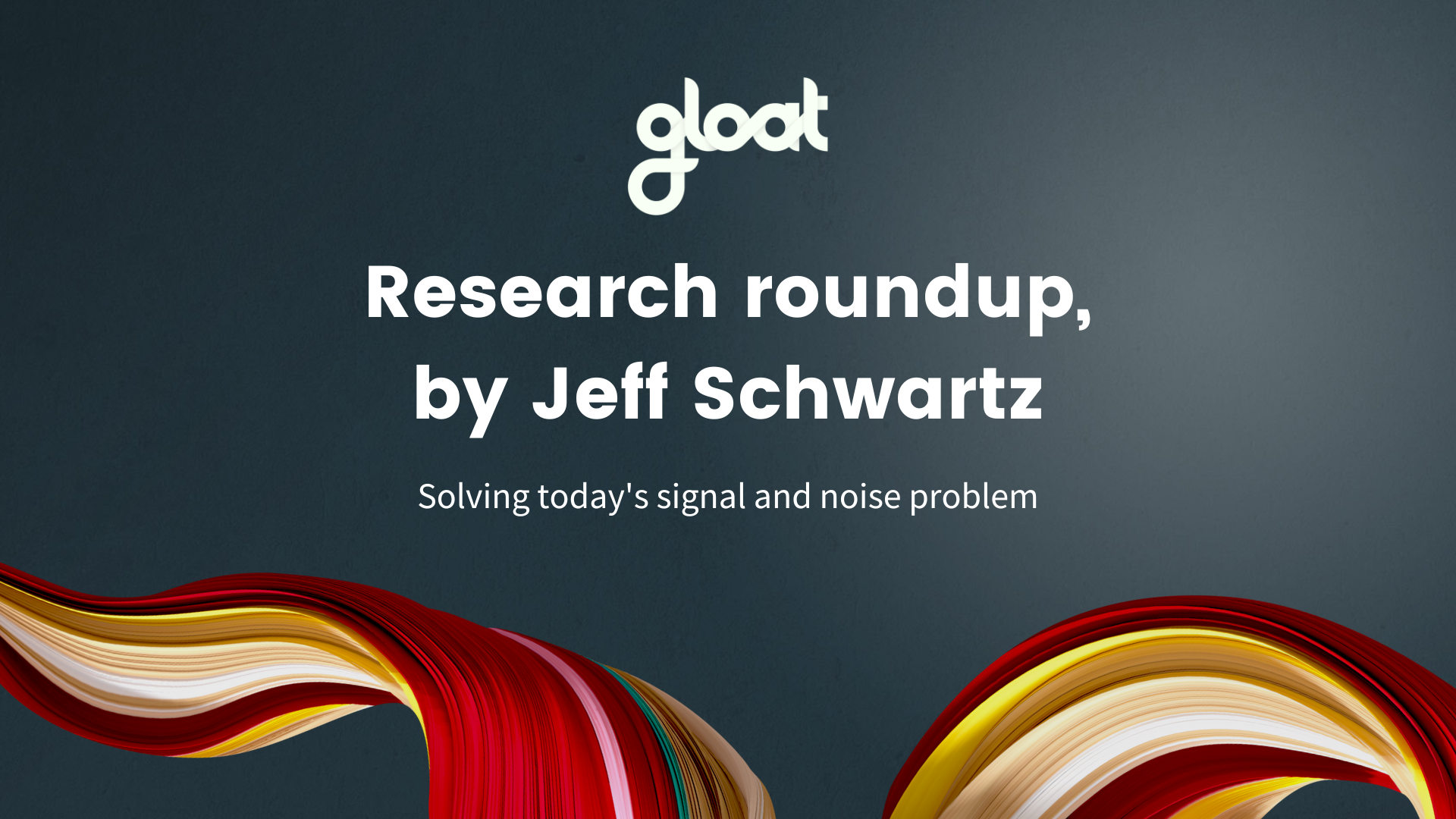January research roundup: Solving today’s signal and noise problem
What I am reading, listening to, and thinking about in the world of talent marketplaces and workforce intelligence

2023 is both an important and, in many ways, a very challenging year. As we start the year, there are a lot of messages bombarding business and HR leaders. In fact, the discussion is growing so loud that we’re now grappling with a signal and noise problem—how do we discern what’s important and where to focus given multiple priorities, including economic headwinds, skill shortages, and the need to chart a post-pandemic path forward?
There are so many different articles, reports, and conversations about 2023 challenges and 2023 priority lists that leaders can’t be faulted for not knowing where to begin. Rather than getting lost in this conversation, I encourage HR to find the signal within all of the noise. I’d argue that our signal is distinguishing changes that are new initiatives designed to make a difference versus incremental improvements from the year prior. As I’ve written before: to change the game, you need to make game-changing moves.
While focusing on upgrading last year’s work might seem less risky, 2023 is a critical time for leaders to plan and make investments in bold moves that will help their organizations get to where they want to be in 2030. To select priorities for 2023, this is a time to zoom out and consider your post-pandemic strategy, the lessons you’ve learned, and the initiatives that will both move you forward and help you navigate the problems in front of us right now.
To help guide you towards those game-changing pivots, this month’s research roundup is dedicated to highlighting a handful of 2023 priority lists that focus on the big-picture changes leaders need to make, rather than gradual improvements that just create more noise. I’ve also included a handful of content pieces spotlighting the cutting-edge ideas that are dominating business and HR conversations. By focusing on these big innovations and overarching talent management trends, every HR leader can build the foundation for the talent management strategy they’ll need to achieve success through 2030 and beyond.
The two signals HR leaders need to hear right now
There are two mega-themes for HR leaders. First, with the new year comes a flurry of predictions and trends reports. I’ve included several here that I think are worth consideration. One caveat though: at the start of each year, it’s important to identify BOTH the long-term shifts on the horizon (think 2030!) that are shaping the future and the incremental trends that are largely a continuation of past priorities.
In 2023—after three years of a pandemic where our collective focus was on adaptability and resilience—we must develop a point of view on what’s next and where we want to be in 2025 and 2030. It’s an opportune time to ask ourselves what actions we can take, including those that are new and may not have been in our plans for the year, that will make a difference now and in the future.
Second is the phenomenon of ChatGPT. Suddenly, we’re all living in an age where AI and computers appear to have passed the Turing test (an idea formulated by Alan Turing in England in 1950 to test whether a machine exhibits intelligent behavior). This is and will be a big deal as many, if not all, workers will find they are working with smart machines and robots. What work can, should, and will be done by AI and machines? What should be done by humans? And how can we design ways of working that allow people and technology to work together? ChatGPT is the latest wake-up call for leaders to pay attention to opportunities for human and machine collaboration.
So here are the pieces I am reading, listening to, and thinking about that focus on the signal, rather than the noise:
READ What’s new in thought leadership about talent marketplaces and the future of work
Predictions for 2023: Redefining Work, The Workforce, And HR, JoshBersin.com, Josh Bersin
In his predictions for 2023, Josh Bersin doesn’t shy away from asking leaders important questions. Some of my favorites include, “How will you redesign your job architecture, find adjacent job roles, and fix and improve your models for succession as your company becomes more dispersed, flattened, and changed by industry disruption?” and “Are you ready to invest heavily in internal mobility, career pathways, and capability academies as solutions?”. He goes on to explain that when it comes to the latter question, leaders don’t have a choice. Josh has been writing one of the industry-leading prediction reports for years and this continues to be an essential piece.
2023 Workforce and HR priorities summary, Brian Heger HR, by Brian Heger
Curious how different workforce and talent management priority lists overlap? Brian Heger created this one-page summary, which highlights shared trends that sources like Gartner, Insight222, and McLean & Company have called out. Some shared priorities to note include building a skills-based organization, humanizing the work experience, and redefining remote and hybrid work strategies. Thanks to Brian for providing a “cheat sheet” to help us quickly look across some of the leading analysts’ priorities for the year.
The Employee Experience Matters: A Key Focus For HR In 2023, Forbes, by Jennifer Rozon
While Jennifer Rozon notes that there are a handful of priorities that HR leaders must keep top of mind, she calls out expanding the employee experience conversation as the focus that stands out most. Although the concept of employee experience might sound simple, most HR leaders know that it’s a complex initiative that encompasses everything from digital technology to your corporate culture. Rozon suggests a few steps leaders can take to enhance employee experience, including creating or reimagining an employee value proposition and addressing burnout at an organizational level. I couldn’t agree more, and this is why I think 2023 will be a key year for the intersection of skills-based organizations, employee experience, and talent marketplaces.
Quiet hiring has certainly become the talent trend of the moment. But beyond the trendy name, internal mobility is the underlying concept that’s fueling quiet hiring’s success. In this Society of Human Resources Management article, I explain that quiet hiring is actually part of a much bigger move away from job-based work structures and towards dynamic skills-based organizations.
After interviewing HR practitioners and HR analysts, the Society of Human Resources Management has come out with its own list of talent management priorities, which Dave Zielinski explores in his writeup. Investing in internal talent marketplaces is one of these trends because, as Forrester Principal Analyst David Brodeur-Johnson explains, “Investments in internal mobility will pay off more than ever in 2023.” New applications of AI designed to enhance recruiting and skills visibility are another innovation that made the list.
LISTEN What I’ve been playing on repeat
Reid Hoffman and ChatGPT | Talking AI with AI, Greymatter, with Reid Hoffman
There’s certainly a lot of buzz around ChatGPT, but it’s difficult to form your own opinions of the tool without experiencing it firsthand. The two podcast episodes I’ve included with Reid Hoffman will give everyone an idea of what ChaptGPT is really capable of. In this first episode, he focuses on the transformational impact that AI is having on facets of society. Take the time to listen to a brilliant mind talking with a mind-boggling technology.
Reid Hoffman and ChatGPT | The Human-AI Partnership, with Reid Hoffman
If you want to learn even more about ChatGPT, don’t miss the second episode of Fireside Chatbots featuring Reid Hoffman and the large language model created by Open AI. During this conversation, Hoffman and ChatGPT talk about the ways humans and AI can work together to significantly increase productivity, scientific discovery, analytical capabilities, and creativity. As ChatGPT explains, “The jobs of the future will likely be a combination of technical and human skills, requiring individuals to be adaptable and able to work with new technologies.”
Workforce ecosystems with Elizabeth J. Altman, Talking about platforms, with Elizabeth J. Altman
This interview with Elizabeth J. Altman is a must-hear conversation if you’re looking to understand more about the role that talent marketplaces and workforce intelligence will play in the new world of work. Altman shares some great insights from our collaboration on workforce ecosystems as part of the MIT Sloan Management Review and Deloitte Consulting research on the future of the workforce. P.S. If you’re interested in learning more, our forthcoming book, Workforce Ecosystems– Reaching Strategic Goals with People, Partners, and Technology, will be published in early April.
Gloat and David Green co-create future of work mini-series, Gloat.com
As leaders strive to reimagine talent management, David Green is serving as a guiding voice by helping executives bring data and people analytics to the forefront of their strategies. Here at Gloat, wesee the game-changing impact that data-driven workforce intelligence tools can have every day, so we decided to partner with Green to co-create a series of episodes for his Digital HR Leaders podcast. Highlights from our collaboration include this interview with Tanuj Kapilasharami—which may be the best story talent marketplace impact story of 2023—and an HR trends conversation with David Ulrich and Diane Gherson that focuses on the disconnect between employee expectations and business needs.
THINK What research and studies are saying about our path forward
Deloitte’s latest Global Human Capital Trends report is filled with important insights for leaders who are striving to prepare for the future of work—or what Deloitte refers to as “a boundaryless world.” The shift from structuring work by jobs to embracing skills-based strategies is one of many important transformations that the report calls out. As Deloitte explains, “When unboxed from jobs, workers have the opportunity to better utilize their capabilities, experiences, and interests in ways that advance organizational and worker outcomes.”
Transformation is at the top of every organization’s agenda (just look at Mercer’s stat that 96% of companies are planning enterprise-wide transformations for proof). Yet, transformations are often challenging and this McKinsey piece aims to explore why. According to the article, digital transformations center on five core talent factors, which include:
- Prioritize hiring senior digital leaders to attract talent and sharpen your value proposition
- Rethink your value proposition for digital talent
- Hire digital talent internally, but keep a high bar on technical skills, and be realistic about reskilling
- Build a learning and development program specifically for digital talent
- Evaluate trade-offs between immediate results and long-term capability building, leveraging temporary contractors to supplement delivery
SUBSCRIBE What you need to sign up for to stay in the know
As talent and workforce conversations grow louder and more important, many leaders are searching for a way to stay updated on the trends that are shaping HR and business conversations. In addition to looking out for these monthly roundups, I suggest signing up for Gloat’s Humble Opinion. The weekly recaps highlight thought-provoking statistics and break down key trends—including quiet hiring, which was the focus of this week’s edition.
Let us know what you would add to our list.





